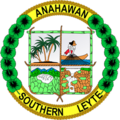Anahawan Last updated December 07, 2025 Municipality in Southern Leyte, Philippines
For the place in the province of Agusan del Sur, see
Sibagat .
Municipality in Eastern Visayas, Philippines
Anahawan , officially the Municipality of Anahawan (Kabalian : Lungsod san Anahawan ; Cebuano : Lungsod sa Anahawan Tagalog : Bayan ng Anahawan municipality in the province of Southern Leyte , Philippines . According to the 2020 census, it has a population of 8,429 people. [ 5]
History The municipality is created as Delgado through Executive Order No. 219 , issued by Governor General Dwight F. Davis on December 2, 1929, which organized 22 barrios —separated from Hinundayan —into the 47th municipality of the once undivided Leyte . [ 6] [ 7] However, its organization only took effect on January 1, 1930. [ 8] By Act No. 3705 dated November 20, the municipality was renamed Anahawan , which would be effective exactly a year after its establishment. [ 9]
Geography Barangays Anahawan is politically subdivided into 14 barangays . Each barangay consists of puroks and some have sitios .
Amagusan Calintaan Canlabian Capacuhan Kagingkingan Lewing Lo-ok Mahalo Mainit Manigawong Poblacion San Vicente Tagup-on Cogon Climate Climate data for Anahawan, Southern Leyte Month Jan Feb Mar Apr May Jun Jul Aug Sep Oct Nov Dec Year Mean daily maximum °C (°F) 28 29 29 30 30 30 29 29 29 29 29 29 29 Mean daily minimum °C (°F) 23 22 23 24 25 25 25 25 25 25 24 23 24 Average precipitation mm (inches) 78 57 84 79 118 181 178 169 172 180 174 128 1,598 Average rainy days 16.7 13.8 17.3 18.5 23.2 26.5 27.1 26.0 26.4 27.5 24.6 21.0 268.6 Source: Meteoblue [ 10]
Demographics Population census of Anahawan Year ±% p.a. 1939 5,086 — 1948 4,703 −0.87% 1960 5,545 +1.38% 1970 6,094 +0.95% 1975 6,875 +2.45% 1980 6,544 −0.98% 1990 7,063 +0.77% 1995 6,471 −1.63% 2000 7,209 +2.34% 2007 8,032 +1.50% 2010 7,942 −0.41% 2015 8,211 +0.64% 2020 8,429 +0.55% 2024 8,766 +0.95% Source: Philippine Statistics Authority . [ 11] [ 12] [ 13] [ 14]
References ↑ Municipality of Anahawan | (DILG) ↑ "2015 Census of Population, Report No. 3 – Population, Land Area, and Population Density" (PDF) . Philippine Statistics Authority . Quezon City, Philippines. August 2016. ISSN 0117-1453 . Archived (PDF) from the original on May 25, 2021. Retrieved July 16, 2021 . ↑ "2024 Census of Population (POPCEN) Population Counts Declared Official by the President" . Philippine Statistics Authority. 17 July 2025. Retrieved 18 July 2025 . ↑ "PSA Releases the 2021 City and Municipal Level Poverty Estimates" . Philippine Statistics Authority. 2 April 2024. Retrieved 28 April 2024 . ↑ "2024 Census of Population (POPCEN) Population Counts Declared Official by the President" . Philippine Statistics Authority. 17 July 2025. Retrieved 18 July 2025 . ↑ Executive Orders and Proclamations, 1929 Manila : Bureau of Printing. 1930. pp. 104– 106. Retrieved September 13, 2025 – via Internet Archive . ↑ Annual Report of the Governor General of the Philippine Islands, 1929 Washington, D.C. : U.S. Government Printing Office . 1931. p. 30. Retrieved September 13, 2025 – via Google Books . ↑ Annual Report of the Governor General of the Philippine Islands, 1930 Washington, D.C. : U.S. Government Printing Office . 1932. p. 41. Retrieved September 13, 2025 – via Google Books . ↑ Act No. 3705 (November 20, 1930), An Act Providing that the Municipality of Delgado, Leyte, shall be Called "Anahawan." , retrieved September 13, 2025 ↑ "Anahawan, Southern Leyte : Average Temperatures and Rainfall" . Meteoblue. Retrieved 6 January 2019 . ↑ Census of Population (2015). "Region VIII (Eastern Visayas)" . Total Population by Province, City, Municipality and Barangay . Philippine Statistics Authority . Retrieved 20 June 2016 . ↑ Census of Population and Housing (2010). "Region VIII (Eastern Visayas)" (PDF) . Total Population by Province, City, Municipality and Barangay . National Statistics Office . Retrieved 29 June 2016 . ↑ Censuses of Population (1903–2007). "Region VIII (Eastern Visayas)" . Table 1. Population Enumerated in Various Censuses by Province/Highly Urbanized City: 1903 to 2007 National Statistics Office . ↑ "Province of" . Municipality Population Data . Local Water Utilities Administration Research Division. Retrieved 17 December 2016 . ↑ "Poverty incidence (PI):" . Philippine Statistics Authority. Retrieved December 28, 2020 . ↑ "Estimation of Local Poverty in the Philippines" (PDF) . Philippine Statistics Authority. 29 November 2005. ↑ "2003 City and Municipal Level Poverty Estimates" (PDF) . Philippine Statistics Authority. 23 March 2009. ↑ "City and Municipal Level Poverty Estimates; 2006 and 2009" (PDF) . Philippine Statistics Authority. 3 August 2012. ↑ "2012 Municipal and City Level Poverty Estimates" (PDF) . Philippine Statistics Authority. 31 May 2016. ↑ "Municipal and City Level Small Area Poverty Estimates; 2009, 2012 and 2015" . Philippine Statistics Authority. 10 July 2019. ↑ "PSA Releases the 2018 Municipal and City Level Poverty Estimates" . Philippine Statistics Authority. 15 December 2021. Retrieved 22 January 2022 . ↑ "PSA Releases the 2021 City and Municipal Level Poverty Estimates" . Philippine Statistics Authority. 2 April 2024. Retrieved 28 April 2024 . External links
Places adjacent to Anahawan
This page is based on this
Wikipedia article Text is available under the
CC BY-SA 4.0 license; additional terms may apply.
Images, videos and audio are available under their respective licenses.




